Sergio
Barani is an orchidist since he was 11 years old and has
been cultivating orchids as professional for more than 20 years.
Nowadays he is recognized as one of the greatest Brazilian breeders.
His creations take part in the most important show in Brazil and
his masterpieces are Blc Bruno Bruno and Cattleya Fátima Barani. His nursery is Nobile Orchids.
ON:
Barani, you are a civil engineer, how did you get inside the world
of orchids and how did you decide to make this a profession?
SB:
Orchids came before the engineering. In fact, I had my associate
card in an orchid society when I was eleven years old. At this age,
I was already a mascot of the society. The engineering came later.
ON:
Very premature! How did it happen?
SB: I had a neighbor which hobby was birds and orchids. He was a
close friend to my grandparents and my parents. I used to watch
him dealing with the orchids. I found it very beautiful. He gave
many orchids, back-bulbs.
By this time, we used to put the back-bulbs
in a grape box to make them sprout, thus I had 30 or 40 orchids
and I should build a bower.
|
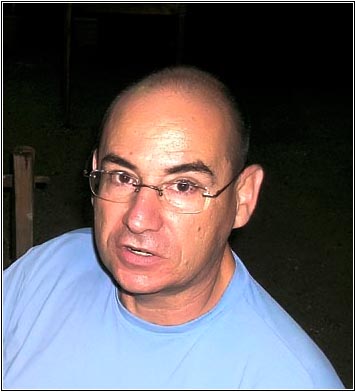 |
One day, he decided to bring to the
meeting of the Associação de Orquídeas e Canários
do ABC (Local society for orchids and birds gathering Santo André,
São Bernardo and São Caetano in the state of Sao Paulo),
I liked this game. There I met many orchidists as Alfredo Martinelli.
Suddenly, people started to give me orchids and I saw myself with
hundreds orchids and I went on attending regularly the meetings
from 11 to 13 or 14 years, but I grew up, the time to go to the
parties came. So, I sold my orchids to my father. Years later, when
I was 18 years, I met my future wife, Fátima and she only
got orchids, for her birthday, Christmas, anniversary of our love,
when she got sick, when she recovered... We started when I was 18
and it took 6 years before we got married, time to build a new nursery.
We did many orchid excursion, went to many shows and when we got
married, I had again 200 or 300 orchids in my mother-in-law home
and once more I got back to the orchids.
ON:
How was this return? How old exactly were you?
SB: It was a return for the origins because the Sociedade de Orquidófilos
de Santo André (Local Orchid Society) – SOSA was practically
the same I had attend when I was teenager and was inactive. That
was a re-foundation with Martinelli again, Geraldo de Assis, Francisco
S. B. David (Paco), Wilson Sosnoski and many others. I participated
in this re-foundation and stayed there for many years. Thus, when
I was 17 or 18 years old, I got back to the orchids, once again
I had them at home.
ON:
So you have a long relationship with Martinelli. What could you
tell us about him?
SB: Fantastic great personality. Someone completely in love with
he did, he gathered orchids and orchids. He worked a lot, but really
a lot for CAOB (Brazilian Orchid Societies Coordination) from which
he has been the president for many years. I just can say that he
was a trustworthy fellow, always helpful, always ready to conciliate
a quarrel about points and every thing. He cooked a good pasta.
This is the souvenir I had from him, always in a good mood.
ON: He was a character inside the Brazilian orchid world,
how do you place him mainly in the state of São Paulo ?
SB: He was the base of the orchid world in São Paulo, basically
he supported CAOB, he was the CAOB during long time in many shows.
During my teenage and even a little more, you could go to any show
in the interior, CAOB was Martinelli. I don't know how Coab run
but the only thing I saw during many years was Martinelli at the
head of CAOB. In all shows in the interior of the state, in every
place you went, the little Italian was there, always in shirt-sleeves,
no matter if it was cold or not, always rubbing hands, I've never
seen that man with a warm clothing.
ON:
Backing to your history, meanwhile you graduated in engineering
but you haven't practiced?
SB: Yes, I practiced for a while. When I was fourteen years old,
I already worked with projects, I was a designer. By this time,
mainly in my Italian ascendancy family which hadn't doubtful words,
they didn't put the discussion if it was or not politically correctly
to work when we are fourteen. If we were able to work, we would
worked. By this time, there is no discussion about exploiting minor.
I hade my first employment book signed when I was 14 years old,
in an industry of metallic construction where I did a course of
drawing. When I was 15, I designed, at 18, I was a draftsman. I
earn much more before going to engineering college than when I finished
the course. In order to support my course, I give classes in mechanical
design for 12 years in SENAI school and even when I finished engineering,
I went on giving lessons for a while, doing repairs and small constructions.
However, soon I received the invitation to go to Guararema taking
care of orchids, where I lived for 15 years.
ON:
You also had a relationship with the great Rolf Altenburg (http://tinyurl.com/y9gkl3c),
from Florália, how was this experience? You can say that
he was the personality in the orchid world who most influenced you?
SB: I should say that I owe him my start in the professional life,
let's put it in another way, he helped a lot and my "indoctrination"
has been his catalog and his way of working. I can say that I learnt
from him since I was very young. My society always received Florália's
catalog, we studied it carefully and put a mark in what interested
us and we discussed with Martinelli and another skillful associates.
By this time people should really know about orchidist. At the beginning
his catalog hadn't photos, so we discussed about the parents in
the cross and what they could generate: “- This can be good,
so 5 plants, this one is more speculative, it can be good or not,
so 3 plants”. I saved money and when the new catalog was released,
I practically "sweep" it. Three, five, ten of each one,
always a seedling because I hadn't money enough. I bought a lot
in order to have the opportunity to have something good. I had acquaintance
with Rolf but it was a long distance contact, I only attend to his
nursery from 10 to 15 times, at maximum. When I came to buy with
him, he already knew me as amateur and he was very kind with me
may be because I was really interested in what he did and for being
a constant customer. I wanted to know how everything worked: “-
This one I don't know, what is this? Which was your purpose? What
can be improved?” may be it stimulated Rolf to help me when
I talked about being a professional breeder. Once when I had already
free access to the collection, he let me walk around and went to
the office, something very interesting happened. He had imported
many Odontoglossum hybrids from Germany, adult plants, just about
to bloom, wonderful things with spikes a meter long. They were the
first Odontos in Brazil. This time, some have already one or two
opened flowers. I asked him if he could sell me some and he answered:
“- I got them for matrices.” He had imported 500 or
a thousand plants and I insisted if he could sell me about 30 because
there were many crosses and inside the same crosses there was many
variations. He finally answered: “- I sell ”. “Can
I choose?” “– Yes”. He went to the office
and I, as a carefully orchid lover, spent with Fátima, one
or two hours looking for small spots, macula, good shapes and so
on. - "This is the best, that is the best." I compared
one by one. There was a small garden wall where I put the plants.
I called him and told I have already chosen them. He looked at me
and said: “- Those are mine, I trust your good capacity for
choosing them, now you can choose yours.” I told him: “This
is unfair”. Rolf answered: “- Unfair is to buy many
plants to do matrices and someone come, at very first blooming and
choose the best. I didn't choose none and I enjoyed your choice,
so those are mine and now choose yours”. Then I started all
over again. It is a healthy joke, after all, I was learning. When
I started as professional, I was looking for matrices and nobody
wanted to sell me them. I went to Mr. Rolf and asked him if he could
helped me, he allowed me to choose some plants in his collection.
It was about going on in the same breed line he was doing to see
what would help ahead. He told me to choose some plants but I haven't
much money and told it him. He answered: “- Let's see what
you want and then we will discuss about the money”. I remember
well it was november or december and he let me choose 50 plants,
when I was at the thirtieth, I thought: “I am deeply in debt,
I can't afford it”. So, after having choosing 50, Mr. Rolf
called an employee and asked him: ”- How much costs an ordinary
Laelia purpurata?". That's why I know it was the end of
the year. He answered that it was something like 10,00 U$. So Rolf
said: “- I have a lot of friends, I would create strong enmity
among them if I give those plants, so I will sell to you."
The price he asked was the same price of an ordinary Laelia
purpurata discarded in the shop. Today, I would buy 50 excellent
matrices and pay 500,00 U$ or something like that.
ON:
Very interesting and cool his vision in having a continuity in this
work.
SB: He felt that I was interested. He never denied me an information,
even after having my trade, we had a doubt about a very good plant,
still used as semi-alba matrix. Patiently, he searched in his registers
and gave the information. Another interesting event, he had a C.
schilleriana coerulea that he didn't sell in Brazil, just abroad.
It was a rarity and he gave me one provided I never bring it to
a show nor tell its origin.
ON:
It means, your starting point had Rolf's little help?
SB: A little help no, a beautiful push. If you have a look on my
first crosses, the plants were basically from Rolf Altenburg's collection.
By this time, in the country, there nothing better, to hybridize,
in lilac than Lc Rolf Altenburg (registered in l979), it
was the top. Nothing better than a good Cattleya Enid,
a Bc. Pastoral. He had already done Bc. Pastoral's
daughters, there was Bc. Turandot (Bc. Pastoral
x C. Bob Betts), one of them is ‘Guaxupé’,
a very good shape but it not so floriferous as Bc. Turandot
‘Araraquara’, a very good matrix.
ON:
Do you still remember which plants you have got?
SB: All 50 no, I can't remember all of them. We had good alba such
as C. Francis TC Au, C. Jack Cole, semi alba
such as Cattleya Enid, Blc Enid Moore, good lilac
such as Bc Turandot, Lc Rolf Altenburg, Blc.
Roberto Cardoso, Lc. João Antonio Nicoli, Bc.
Pastoral, Lc. Tyl Belle, etc.
ON:
When it happened?
SB: By 85, 86, when I went to Guararema.
ON:
Besides Rolf, in your opinion, who did the history in Brazil concerning
the hybrids of the Laelinae group?
SB: Waldemar Silva did many crosses. In Amparo (state of São
Paulo), Paulino Rech had a big nursery. He hybridized a lot but
the difference is that he never registered his hybrids while was
Waldemar Silva registered 114 hybrids. I met him once, in his nursery
but Waldemar Silva I never met him. Many other breeders did hybrids
but, unfortunately, they didn't registered the crosses, Jorge Verboonen,
Evaldo Wenzel, George Suzuki, Seidel, Yamagushi; those I remember
but I remained circumscribed to São Paulo, the shows at ABC,
in fact, I didn't travel a lot, I went to Guaxupé, Rio Claro,
Rio, but I didn't go away ... Still today, I am not used to travel
a lot.
ON:
Which were the great hybrids of Cattleya, the big clones,
the great matrices, done in Brazil?
SB: We should analyze the genealogical tree of all Brazilian hybrids
in order not to lose merit of any ancestral. Besides, a good matrix
can never receive a award in the shows and plants with high punctuation
and award can not be good matrices. We have many good hybrids but
we don't have official judges, that is the problem, so we don't
have official awards which do not allowed our good plants to have
their value be recognized here and abroad. Our awarded plants are
limited to the visits of the American judges pay to AOSP, OrquidaRio
and (now) Joinville shows. Except for those three shows, we don't
have judgments, so there are many good plants but we depend on having
opened flowers during those few opportunities. Good matrices, just
for talking about Rolf Altenburg's ones: Bc. Pastoral,
1961, it has been used in 239 registered crosses, Lc. José
Dias Castro, 1966, 50 crosses, Blc. Enid Moore, 1980, 22
times, Lc. João Antonio Nicoli, 1972, 19 times,
etc. C. Sonia Altenburg, wonderful semi-alba, unfortunately
not very fertile, has received an AM. Lc Sheila Lauterbach
was our only FCC, I don't know if we have something more, Roberto
Agnes (Aranda), Sandra (Florália), César Wenzel (Wenzel
Orchids), Antonio Schmidt (Bela Vista Orchids) took plants abroad
and getting, in this way, good opportunities.
ON:
It was the clone 'Equilab' of Lc. Sheila Lauterbach that
got a FCC/AOS with 90 points, in 2.000. In 2008, in Joinville show,
we had a Blc. Durigan with seven awards.
SB:
It was a fantastic Blc. Durigan, at about 50 plants among
the best...
ON: In the work you presented in the "1st
Congress Oriental /Brasil Orquídeas", you said that
the orchid market can be divided into two segments: orchids for
the orchidists and orchids to decoration market, but you finished
for reaching the two segments.
SB:
My first aim was to produce flowers for decoration, floriculture
commerce, I didn't intend produce flower for orchidists, for attaining
award. However quality is desirable in every where. A colorful flowers
is beautiful for the decoration and is beautiful for the orchidist;
a good shape bring money in the decoration and bring punctuation
in the orchid judgment ; a bigger number of flowers is good for
decoration and is also good for the orchidist. Quality is quality.
Although the aim of my work is commercial, good plants appear, are
judged and get awards, arising orchidists interest. So the necessity
of internet, catalog, to reach the orchidists is compulsory because
we can not dissociate, at least, completely, the aims. In this way,
I satisfy the needs of the orchidist market breeding for the decoration
market.
ON: What are you still looking for?
SB: In breeding with orchids, the search is slow, constant and endless.
Some times, we are looking for something and we find another thing;
we want to aggregate a genetic characteristic and we finished for
bringing a “gift” that we don't want, forcing us to
do a new cross. Genetically speaking, we do not know exactly what
happens when we do a cross. My work is based in the search of some
characteristics which are more and more essential for making a hybrid
a commercial success. The season of blooming, the precocity of the
blooming, the durability, the color, the shape, the substance, the
size of the flowers, the number of flower per spike, the ovary length,
the rhizome length, the scent, the plants vigor, the resistance
to pests and diseases, the response for cultivation conditions,
etc.
ON:
Let's start with the first characteristic you mentioned. Why the
blooming season is so important?
SB:
The season is determinant for the market because the consumption
varies according to the commemorative dates such as Mother's Day,
Valentine's Day, Secretary's Day, All Souls' Day, Christmas Day,
New Year and another religious dates. Those occasions offer to the
producers a opportunity of having a better sale because the consumption
increases. The tradesman who, normally, ask for 10 plants, during
the Mother's Day, wants 100. This is the peak moment of the consumption
during the first semester. If we wish or not, the blooming peak
of Cattleya hybrids is the first semester which is, concerning
the inner market, very complicated. In January, the consumer is
on holidays, the towns are deserted. In February, there are many
“extra” expenses, there is the Carnival, people travel
a little more... March is a little bit better because there are
some shows however it is Lent period when people can't marry because
it causes bad luck. We get inside April which is always an interrogative
situation... Some times a “gap” appears before the order
for Mother's Day... In terms of flowers commercialization, the beginning
of the year is not so good as it could be due to the cultural characteristics
of or country. The orchid market will be better when the best of
our Cattleyas are finishing their better blooming, May or June when
we have a strong presence of Cymbidiuns showing the beginning of
the second semester which is, in terms of quantity, for the Dendrobiuns
and Phalaenopsis. It is up to the producers and tradesman break
this commercial paradigm.
ON: And for the orchidist, the blooming season is also important?
SB:
For the orchidist who participates to the shows, the blooming season
is also important. He wants to have his plants open one or two days
before the show in order to exhibit them to the judges and to the
audience. Most people who do not travel a lot have 80% of their
collection formed by plants bought during the shows in their cities.
In other words, plants of all collection in the town will bloom
at the same time and rest of the year, just a few plants blooming.
An active orchidist need to have plants blooming all year around
to contribute to his society which should participate in shows of
different societies all year in order to guarantee the participation
of the societies on its own shows. Without guests, it is difficult
to do a good show. For that reason, it is important to produce hybrids
which bloom in any season of the year.
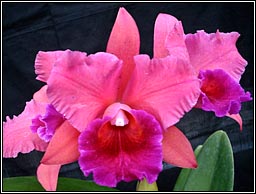 |
Blc.
Nobile's Tango 'Buenos Aires
Comment:
A cross of Lc. Irene Finney × Blc. Nobile’s
Bruno Bruno. It blooms in Springtime.
Done for reinforcing the production of the end of the year,
it resulted in a multiflora plant with medium flowers which
has a more vivid lilac than the others blooming in the same
season. |
ON:
Why there is a relation between the season of year and the color?
SB:
In the first semester, when the wholesaler see a plant with four
large yellow flowers, he usually says: “- Just four? There
is no plant with five? It is not exactly this yellow I wanted, I
would like a yellow a little bit vivid”. As it has many varieties
and the demand is retracted, the law of supply and demand visibly
prevails. The “lilac fell in disgrace” for a decade
now, the price is stagnated, however the plants cost the same for
being produced, it takes the same time and occupies the same room.
During the first semester, it is still more devalued. Why? Because
it is the Cattleya blooming peak, everything is opening.
The talk is like that: “- Is it lilac? I don't pay more than
ten or fifteen, is it yellow or red? I pay up to R$ 25,00”.
During the second semester when there is a lack of Cattleya
with large flowers, the talk changes, nobody wants to know the color
or how many buds there is inside the sheath; all colors are sold
by the same price. We are talk about wholesale.
ON:
There is no place to amateur, we should know the tendency of the
market in order not to make mistakes...
SB:
I got inside the market when we could do anything in terms of hybridization
because it was saleable. Few people participated in this market
because the knowledge about breeding was dominated by just few.
Here in Brazil, the only company which withheld the process of cloning
a plant was "Equilab" which was starting in this market.
When the customer want to have a better quality plant he only should
buy crosses and should have good luck to obtain a good plant. With
the clonage, not only the professional but also de customer have
access to very high quality plants with a retail trade price. Nowadays
the smallest mistake represents a loss because the profit margin
decreased since we cultivate in a big scale, in a more aggressive
market, in many meanings. While the hybridization, talking commercially,
became a high risk activity as it can't be done in a speculative
way and/or in a large scale since it turn into having as a main
characteristic the function of being the supplier of "novelties"
for the flower production industry.
ON:
Could you give some example of plants blooming in commemorative
dates such Mother's Day, for example?
SB:
Cattleya Fátima Barani is an example in lilac. Potinara
Helga Margaret Gray, hybrids using Blc. Goldenzelle, also
bloom in this time, we have good yellows such as Blc. Nobile’s
Golden Top, Blc. Nobile’s Golden Dunes, etc.
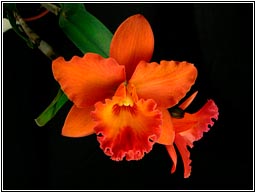 |
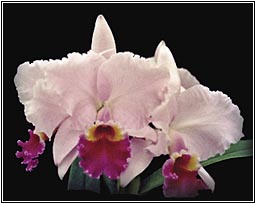 |
Potinara Helga Margaret Gray |
Cattleya Fátima Barani |
ON:
And the second characteristic, the precocity of blooming?
SB:
It is very important, it is directly linked to the costs, becoming
a determinant factor for a more lucrative production. A plant with
a precocious blooming will occupies a room for a smaller time giving
space for another. Some species of Laelia and also bifoliate
Cattleya transmit this quality for their progeny. Another
genera such as Oncidium, Cymbidium, Phalaenopsis
and Dendrobrium are considered as fast plants, they can
blooming within 3 years but the group of Cattleya takes
in general, the double. With the genetic and cultivation techniques,
we succeeded in reduced this time.
ON: How long take a precocious plant inside the group of
Cattleya?
SB:
We can talk about 4 years.
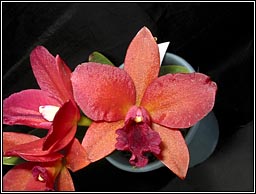 |
Blc.
Nobile's Pop 'The First’
Comment:
It is a cross de Lc. Chocotome Gold × Blc.
Nobile’s Bruno Bruno and blooming from the Summer until
the Winter. It has a pleasant scent, presenting red flowers
from 4 to 5cm across, precocious blooming. In the first blooming,
it bears 2 or 3 flowers but it has potential to bear up to
10 flowers in the subsequent blooming.
|
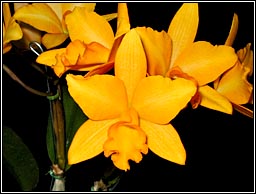 |
Blc.
Nobile's Soleil
Comment:
It is a cross de Blc. Kure Beach × Lc.
Blazing Treat, with precocious blooming in Springtime bearing
many flowers per spike from 4 to 6 cm across. The color varies
between the yellow and orange. It blooms between the third
and fourth trimester when there are just few Cattleyas available
in the market. In this cross, rupicolous and bifoliate plants
have been used which allow the generation of floriferous plants
that when adults will be like their parents bearing from eight
to twelve flowers. In the show, it is an easy plant to be
sold, even when with just few flowers. |
ON:
Going on with the desirable characteristics...
SB:
Size and number of flowers per spike, length of the ovary and rhizome,
this is concerning the orchidist, but commercially is also important.
ON:
Why the length of the ovary is so important?
SB:
Just few people care about it, but it is a question of the appearance
in all plant. Ovary too much long make the flowers not to be upheld
in the spike, turning down which is a characteristic of Rhyncholaelia
(Brassavola) digbyana, for example. Together with
the large and lacework lip, comes this “problem”. For
a good presentation, the flowers should be propped with stakes.
On the other hand, a short ovary finishes for impairing the plant
appearance, making difficult the opening of the flowers and when
there are many flowers in the same spike, they become heaped. The
length of the ovary should be proportional to the size of the flower.
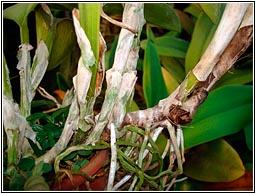
ON: And about the rhizome?
SB: The short rhizome brings economy in the costs
for the producer because the plants stay more time in the
same pot and, at the same time, the appearance is more pleasant,
the plant has a good demeanor, more compact. A too large rhizome
makes the repot more frequent. Plants such as Bc.
Pastoral or Blc. Norman’s Bay, for example,
when used as matrices produce plants with a 5-7 cm long rhizome,
making the replant more frequent to keep the plant inside
the pot. Although most people don't look for the "bottom
of the plant" when they are enchanted by the flowers,
it is an important point to be verified mainly when it is
a matter of producing. If the plant has a large rhizome, the
work will increase. |
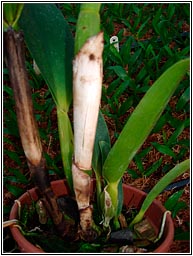 the right lenght
the right lenght |
ON:
Bc Pastoral has another characteristic, which are the consequences
brings in breeding?
SB:
Lilac is a dominant color and as Bc Pastoral alba or semi-alba
is a false albino, it is not useful to cross it with an alba, semi-alba,
yellow, red, or any other color. The result will be majority lilac.
ON:
And you can say about the importance of the color?
SB:
The color in Cattleya judgment worth 30 points, so it is
very important for the orchidist. In the judgment as well in the
market, the price or the points are associated to stable colors.
A good color makes the plants be worth more. It can be monochromatic,
like a watercolor, maculate, it can have spots, but the color should
be uniform and in the "right place". Yellow should be
vivid, if it is not, the price drops down in the decoration market
and it loses points in the judgment. The customer is latin, he appreciates
the spherical shape, he likes, essentially, hot colors; yellows
and red are on top. Phalaenopsis and Denphal broke this
routine. Vivid and hot colors, even "mixed", such as yellow
and red in Blc. Nobile’s Wild Fire and Blc.
Nobile’s Tropical Sunset, mean well succeeded sales, in the
decoration market as well in orchid world. Blc. Nobile’s
Tropical Sunset is a result of excellent matrices Blc.
Julio Barbero and Blc. Hsinying Gold.
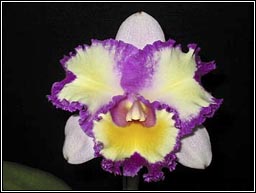
|
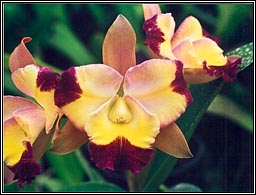 |
Blc. Nobile's Flash |
Blc Shiniti Ishikawa 'Easy' |
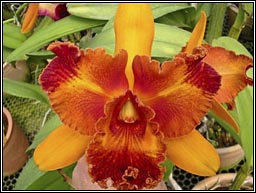 |
Blc.
Nobile's Wildfire 'Arabesc'
Comment:
A cross of Blc. Eve Marie Barnett and Blc.
Julio Barbero which blooms in Summer. The color varies from
the yellow and orange to red, with a high percentage of
flamea. |
Blc.
Nobile's Starlux 'Ocrelinea'
Comment:
Interesting effect, brush stroke of vivid yellow on the
petals an sepals over the yellow. It is a cross de Blc.
Julio Barbero x Blc. Hawaiian Treasure. |
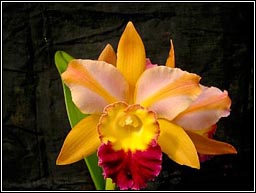 |
|
|
Blc. Nobile's Tropical Sunset 'Fábula' |
Blc. Nobile's Tropical Sunset 'Feliz Natal' |
|
|
Blc. Nobile's Tropical Sunset 'Festa' |
Blc. Nobile's Tropical Sunset 'Firebird' |
Comment:
Blc. Nobile's Tropical Sunset
It is a cross of Lc. Hsinying Gold × Blc.
Julio Barbero and blooms from Springtime until Summer. It
bears from 4 to 5 flowers with good substance, medium size,
yellow with red flamea. |
.
ON:
And about the number of the flowers, which examples should be done?
SB:
Blc. Nobile's Bruno Bruno, Blc. Nobile's Honey,
Blc. Nobile's Thathá, the last one pays homage to
my daughter Thaís. This is a plant that will be produced
because it has everything good. The matured plants already selected,
bear from 7 to 8 flowers per spike, some go to the yellow when they
are open then become orange-yellow like pumpkin. Some are monofoliate
which is better to the culture and to the shipment, the medium size
flowers are pleasant scented.
|
|
Blc.
Nobile's Bruno Bruno |
Blc.
Nobile's Honey
(Blc. Hawaiian Galaxy x C. Chocolate Drop) |
|
Blc.
Nobile's Thatha
Comment:
A cross of Blc. Ademar Manariniand Blc.
Reina Criolla, blooming in Summer. It is a result of plants
which produce orange large flowers with good substance. It
bears a high number of flowers per spike and the color of
the lip is vivid. |
ON:
And about the size of the flower?
SB:
Commercially I have an expression “decorated volume”.
It is the point where we look when we see the plant, where the inflorescence
is. This volume is determinate by the number, the size and shape
of the flowers. The more the flowers are large, numerous and good
shape, the bigger this volume is and, in general, the price is directly
proportional to this volume.
|
|
Blc. Nobile's Tropicana |
Blc. Nobile's Goddess 'Saka
(Lc. Amber Glow x Blc. Julio
Barbero) |
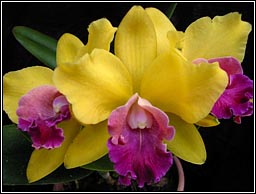 |
Blc.
Nobile's Aura 'Joinha'
Comment:
It is a cross Blc. Peach Cobbler and Blc.
Hawaiian Galaxy. Although the flowers are medium size, it
is multiflora keeping the good visual composition. |
Blc.
Nobile's Suprema
Comment:
It is a cross of Blc. Lourdes Panucci x Lc.
Beatriz Künning.
It produces large good shape flowers with more than 20cm across. |
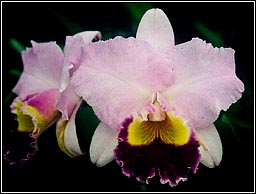 |
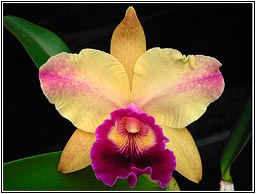 |
Blc
Maripá
Comment:
It is a cross of Blc. Goldenzelle x Blc.
Nobile's Red Fox. Vigorous plants with large flowers. The
color varies from the yellow until the red. Many of them have
yellow-orange flowers with a curious effect reminding watercolors
paints.
|
OON:
And the substance?
SB:
Substance is a very important characteristic because it is directly
connected with the durability of the flower, flowers with good substance
last more time. Plants with substance, for example, bifoliate in
general, generate plants with star shape flowers and very big leaves.
C. leopoldii can produce 20 -25 good substance flowers
by spike, for example.
ON:
How long last those crosses?
SB: Modern crosses with cattleya last from four to five weeks.
ON:
Blc Tatarown has 50% of C. guttata (leopoldii)
as you said, Blc. Durigan has 25% and Blc. Nobile’s
Frisson has 12,5%. This is the only way to obtain a good substance?
Blc. Nobile`s Bruno Bruno has a good substance and also
has 25%.
SB: I say C. guttata because it is the name of the registers
but I always use the C. leopoldii which has a better shape.
Among the bifoliate we can mention C. loddigesii, C.
schilleriana, C. bicolor, C. intermedia,
C. aclandiae, etc.
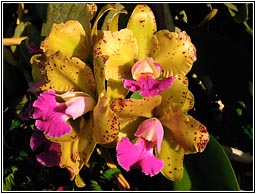
|
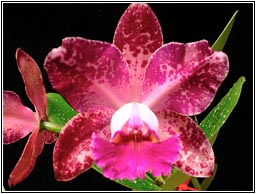 |
Blc. Tatarown
(Blc. Mem Helen Brown x C. guttata) |
Blc. Durigan |
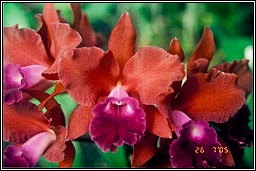 |
Blc. Nobile's Bruno Bruno
|
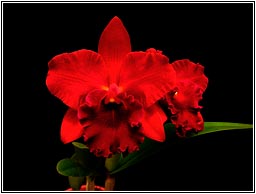 |
Blc.
Nobile’s Frisson
Comment:
It is a cross of Blc. Nobile’s Bruno Bruno
e Blc. Oconee and blooms in fall. The plants with
good substance, vigorous growth can bear more than 5 medium
flowers per spike when adults. The color varies from red to
magenta. |
ON:
And about the shape?
SB:
Shape is essential for orchidist, 30 points...May be this is the
first quality searching by the orchidist at the first sight. Concerning
the decoration, the good shape increases the “decorated volume”,
contributing for the value of the plant. So when we doing a hybrid
where the matrices have already good flowers, strong colors, the
shape is indispensable, even for the multiflora because the difference
of the “decorated volume” is very perceptible. In general,
the improvement of the shape should be followed by the augmentation
of the ovary length for heaving more space in the spike, making
easy the opening of the flowers.
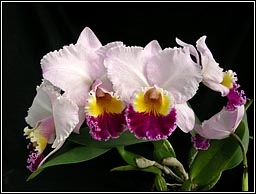 |
Blc.
Nobile's Suprema (Blc. Lourdes Panucci x Lc.
Beatriz Künning)
Comment:
A plant with lilac good shape and large flowers which has
in its progenyBc. Pastoral, C. Tiffin Bells,
Lc Rolf Altenburg.
I don't believe that will produce more than three flowers
per spike, but with the good shape and size, the result is
already very good. |
Blc. Verônica Serra
(Blc. Nobile’s Carnival x Blc. Goldenzelle)
Comment:
Big plant with up to six flowers per spike. There are flowers
with full magenta petals, some others with just a little macula
or without macula on the petals. Almost 50% of the plants
are flamea, its blooming extends until Mothers' Day and, sometimes,
it blooms twice a year. The plants which have Blc.
Goldenzelle in their progeny tend to blooming twice a year
as well as some coming from Blc. Chunyeah.
|
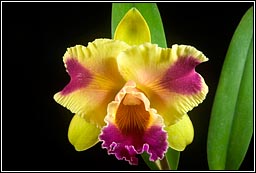 |
|
Blc.
Nobile's Golden Horizon 'Giga'
(Blc.
Goldenzelle x Blc. Dal's Horizon) |
ON:
The good shape of Blc. Nobile's Golden
Horizon is due to the double presence of Blc Goldenzelle?
Blc Dal’s Horizon has 50% of Goldenzelle, it means,
this cross has 75% of Goldenzelle. So we can say that the predominant
presence of C. dowiana (almost 35%) and Cattleya trianaei
(20%) are determinant for a good shape?
SB:
The good shape as well as the other qualities is a characteristic
that will be fixed while we select plants with this quality and
we make new crosses in order to fix this characteristic or, who
knows? to make it better. I don't believe that this quality can
be ascribed to the genetic percentage of the species involved; I
believe that this percentage have influence on the morphological
characteristics, like the bifloliate, or on the blooming season,
for example.
continues

|